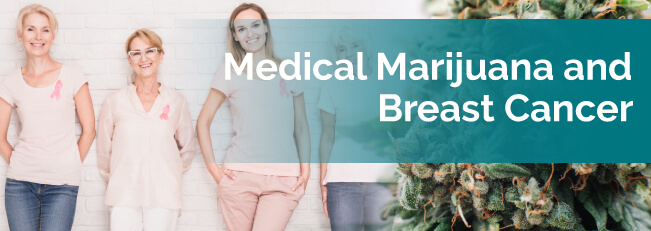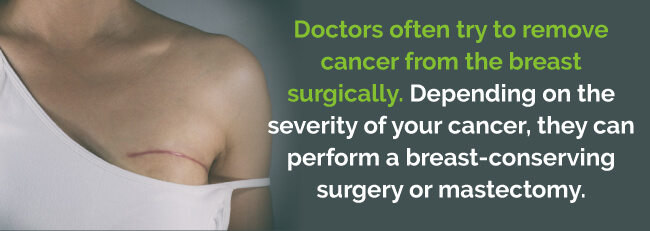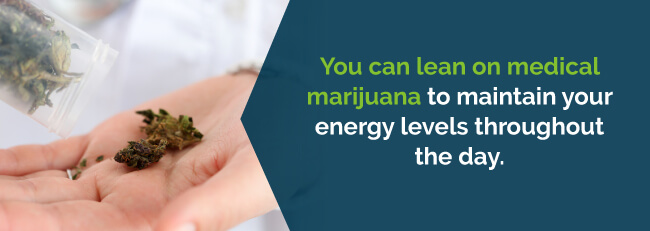
You’ve probably seen someone wearing a pink ribbon to honor the numerous breast cancer patients in the U.S. Breast cancer has touched the lives of many Americans, whether they’ve dealt with it themselves or know a loved one who has.
As with other cancers, researchers continue to look for a cure for breast cancer. Currently, patients undergo harsh treatments such as chemotherapy to treat the disease, while physicians manage the patient’s symptoms separately. Chemo itself causes many side effects difficult to endure.

Medical marijuana has displayed promise for supplementing breast cancer treatment. Read on to learn about medical marijuana and breast cancer.
The female breast is primarily composed of fatty tissue and mammary glands. Mammary glands drain into the lactiferous sinus, which connects them to the nipple. During pregnancy, mammary glands swell in order to accommodate milk production. This process is regulated by hormones. Breast cancer is malignant neoplasm of the mammary gland. It is one of the most common causes of cancer fatality in women. Early detection through regular breast examination and mammography is key. Through self-examination, irregularities such as lumps or masses can be detected before the disease has had a chance to spread. The danger associated with all cancer, but especially with breast cancer, is that the disease can travel quickly once it has invaded the lymphatic system. The lymphatic system provides the perfect harbor for cancers to travel throughout the body. Learn more below about how medical marijuana can help treat breast cancer.
As the name implies, breast cancer is cancer that begins in the breasts. When a person has cancer, their body’s old cells don’t die off, and they create malignant tumors. A cancer is named after the place it begins, so even if breast cancer spreads to other locations in the body, the name doesn’t change.
Most breast cancers start in the ducts used for carrying milk. The second-most-common breast cancer begins in the glands that produce milk. Cancers that occur in other parts of the breast are less common, but they do happen.
Healthy cells become cancerous when the DNA in them mutates. In most cases of breast cancer, the mutation occurs during the patient’s life instead of being inherited. We still don’t entirely understand what causes genes to mutate in this way.
However, we still know some risk factors that increase your likelihood of getting breast cancer. Risk factors you can control include:
But you can’t do anything about other risks, like:
By living a healthy lifestyle and understanding risks you can’t control, you have a better chance of avoiding breast cancer and detecting it if you get it.
There isn’t just one type of breast cancer — it can manifest in different ways. We classify specific types of breast cancer so we can understand how to treat each case.
Breast cancer falls into two different categories based on whether it has spread or not. In situ breast cancers haven’t spread yet, while invasive breast cancers have spread to other parts of the breast or body.
You can further categorize breast cancer into the following diagnoses:
If you find anything unusual when you perform a self-exam, talk with your doctor as soon as possible. Even if you don’t think your symptoms fit into one of these categories, a medical professional can use their expertise to determine the issue.
To minimize the chance of mortality as much as possible, it’s important to detect breast cancer early. Many people with breast cancer don’t experience symptoms, so the easiest way to catch breast cancer before it spreads is to perform regular screenings.
You can check for breast cancer using a few methods. Women over 45 years old should get annual mammograms to track changes in the breasts. Also, you can perform regular self-exams to understand the typical shape and feel of your breasts.

The number one symptom of breast cancer is a lump that wasn’t there before. Hard masses with irregular edges tend to be cancerous, but cancerous lumps can also be soft and rounded. If you find a lump in your breast you didn’t have previously, you should get checked by a doctor right away.
In addition to a lump, other symptoms include swelling in your breast, pain, retracted nipples, discharge and irritation or redness. Breast cancer also causes typical cancer symptoms, like fatigue, pain and extreme weight loss.
Did you know breast cancer is the second-most-lethal cancer for women, only surpassed by lung cancer? You may not know these other breast cancer facts:
The cancer treatment you receive depends on the type and stage of your breast cancer. Additionally, your other health problems influence what treatment you get. For example, some patients can’t have certain kinds of surgeries.
Doctors often try to remove cancer from the breast surgically. Depending on the severity of your cancer, they can perform a breast-conserving surgery or mastectomy. While breast-conserving surgeries only remove part of the breast, mastectomies remove the entire breast.

Some patients receive radiation therapy, usually as a supplement to other treatments. The procedure involves using high-energy rays to destroy the cancer cells in your body. When you get a removal surgery, your doctor will often recommend radiation therapy to lower the chance of the cancer returning.
You might also receive drugs to treat your breast cancer. Chemotherapy, one of the most well-known cancer treatments, can be used to treat patients when they get surgery or when they have advanced breast cancer. Since estrogen can help cancer develop, some patients receive hormone therapy that blocks the estrogen receptors in the breast cancer cells.
However, not all patients have access to these treatments. They might not have the insurance coverage or can’t go through a procedure due to health problems. Plus, many of these methods can put you and your body under a lot of stress. Medical marijuana can help patients find an alternative to the typical routes to address breast cancer.
Not only does medical marijuana have the potential to reduce cancer cells, but it can also relieve the symptoms you experience. While it can’t replace the current treatments we have for cancer, it can complement them to make the side effects easier to manage.
Data suggests non-psychoactive cannabinoid cannabidiol (CBD) could help prevent breast cancer from spreading to other parts of the body. Researchers used a synthetic cannabinoid modeled after CBD on breast cancer cells. They found making compounds that target multiple cannabinoid receptors in breast cancer cells could reduce the likelihood of them spreading.
While the National Cancer Institute states that there isn’t enough evidence to officially recommend cannabis for cancer treatment, it has collected studies and data on the subject. Preclinical trials suggest marijuana can kill cancer cells without harming healthy cells. One study indicates marijuana can enhance chemotherapy, allowing patients to take smaller doses.
Cannabinoids, or cannabis compounds, have shown great potential as an antitumor agent. Antitumor agents kill off cancer cells and prevent them from multiplying. Researchers examined the effects of various cannabinoids on breast cancer cells, specifically focusing on cannabidiol (CBD), cannabigerol (CBG) and cannabichromene (CBC). Since most research before their study looked at THC’s effects, they wanted to get more data on these less-studied components.
The team discovered that CBD and CBD extract worked the best to prevent cancer cell growth. Compared to THC, CBD performed the most effectively. They noted that the CB2 receptor seemed to be involved in their antitumor properties.
Another study discovered that endocannabinoids, or the cannabinoids our bodies make, could also prevent breast cancer cell growth. They examined anandamide, an endocannabinoid that activates the CB1 receptor. When they applied it to isolated breast cancer cells, the cancer cells grew much less frequently. Similar endocannabinoids and synthetic cannabinoids had comparable effects.
It seemed that these cannabinoids interacted with the CB1 receptor to reduce the tumor growth. When they added a substance that blocks the CB1 receptors, the effects of the cannabinoids stopped. Antibodies related to breast milk reduction also appeared to have a relation.
You can also lean on medical marijuana to maintain your energy levels throughout the day. If you feel chronically fatigued, you can use a sativa strain to feel more energy.

On the other hand, if your other symptoms make it difficult to sleep, an indica strain will relax you and help you sleep.
Cannabis can also assist you with some issues related to food and digestion. It can stimulate your appetite to help you maintain your weight. Also, it relieves nausea caused by chemotherapy treatment.
Additionally, pot provides tons of patients with pain relief, whether they have cancer or not. In fact, it’s one of the health problems most commonly treated with marijuana. You can find a strain to target the exact kind of pain you experience.
Using medical marijuana isn’t just limited to smoking. Patients have many options for using their medicine that provide different benefits. The right choice for you will depend on your health problems and other factors. You may also react to certain methods better than others — everyone is uniquely affected by weed.
Let’s take a look at the most popular ways to take marijuana medication:
The best way to figure out what method helps you the most is experimenting with each one under the supervision of your doctor. While exploration can help you find the right choice, taking too high a dose can harm your health.
Patients define the side effects of marijuana, not manufacturers, since cannabis is a natural medicine not produced by pharmaceutical companies. Some of the side effects of medical marijuana actually double as a treatment for breast cancer patients.

The effects that will help people with breast cancer include:
However, other effects of marijuana will function as unwanted side effects for breast cancer patients. Luckily, every one of them has an easy solution. These side effects include:
If you want to try medical marijuana after learning the information on this page, you should do a little more research.
First of all, make sure you can legally use medical marijuana. Cancer patients can use marijuana for medical purposes in 31 states. If you live in one of those states, see if you need to sign up for a medical marijuana program first.
Two important places related to your medical marijuana journey are your dispensary and doctor’s office. A licensed marijuana doctor can advise you on your treatment plan, while a good dispensary will provide your medicine in a safe environment. Search them out today to get the relief you need.
Find A Doctor Find A Dispensary